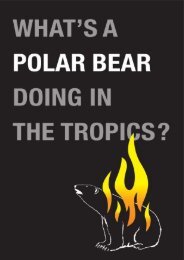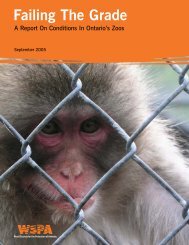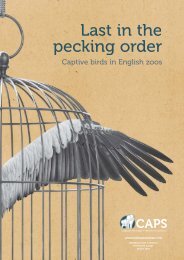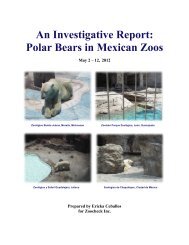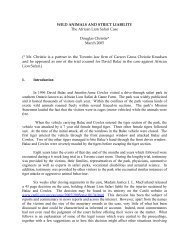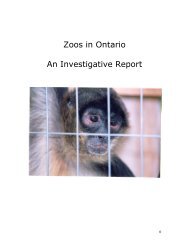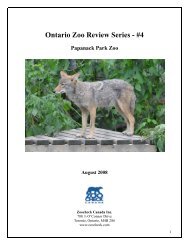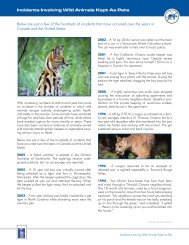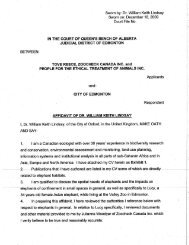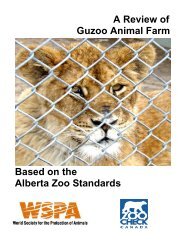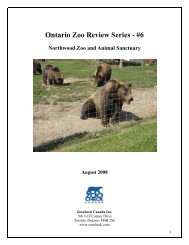STATUS OF BEAR WELFARE
STATUS OF BEAR WELFARE
STATUS OF BEAR WELFARE
Create successful ePaper yourself
Turn your PDF publications into a flip-book with our unique Google optimized e-Paper software.
Status of Bear Welfare in Cherokee, North Carolina<br />
An underlying problem with the housing of bears at SL is the facility’s bear management practice.<br />
At the beginning of every tourist season, the facility acquires a set of black bear cubs from a<br />
breeder and somehow disposes of the pair of adult bears to make room for the new ones. This<br />
practice supports the indiscriminate breeding and supply of black bears for substandard roadside<br />
zoos of which there are dozens in the American Southeast. Bears are bought and sold like<br />
commodities and have no semblance of normal bear life. Bears in this situation suffer enormously<br />
at the hands of uncaring and unskilled people.<br />
ENCLOSURE DESIGN<br />
Lack of Space<br />
The bear enclosures in all three facilities were grossly undersized and entirely failed to satisfy the<br />
spatial requirements of the bears they contained. All bears require large, environmentally<br />
complex, natural spaces that allow them to express a wide range of normal movement and<br />
behavior, including normal wild food-gathering behavior (called “appetitive behavior”).<br />
Compressed spaces that severely hinder or eliminate species-typical behavior inevitably result in<br />
poor physical health, symptoms of which include but are not limited to decreased muscle mass,<br />
depressed cardiovascular health, foot and skeletal issues, and obesity. In addition, the animals<br />
suffer from diminished psychological well-being, symptoms of which include but are not limited to<br />
frustration, anxiety, and boredom, evidenced by prolonged periods of inactivity, stereotypic<br />
behavior, and/or other abnormal behavior.<br />
When compared to the minimum home ranges of bears in the wild, the living spaces of the bears<br />
at the Cherokee zoos were orders of magnitude smaller. For example, at CBZ, two brown bears<br />
were housed in a pit-style enclosure that measured approximately 14 feet (4.26 meters) by 20<br />
feet (6.09 meters)—a remarkably tiny 280 square feet (25.94 square meters). This enclosure was<br />
hardly adequate as a temporary holding facility, let alone permanent housing. Two adjacent<br />
enclosures at this facility, one housing another two brown bears and the third holding two<br />
American black bears, were approximately 560 square feet (51.88 square meters), while the<br />
remaining enclosure housing four American black bears was approximately 54 feet (16.45<br />
meters) by 20 feet (6.09 meters), or 1080 square feet (100.18 square meters). In the wild, home<br />
range sizes for bears can vary from dozens of square miles up to thousands of square miles.<br />
The pits at CSBP varied in size from being marginally larger than those at the CBZ to marginally<br />
smaller. There were two enclosures for bears at SL, one housing two American black bear cubs<br />
roughly estimated to be about 600 to 700 square feet on a hardpan dirt floor, and a second<br />
housing two adult black bears in an extremely small exhibit that was approximately 100 square<br />
feet with a concrete floor, canopied chain-link fencing, and a very small den of approximately 36<br />
square feet. Both cages were grossly undersized, with the adult bear enclosure ranking as the<br />
smallest encountered in the three facilities.<br />
Lack of Privacy<br />
The crowded living conditions and poorly designed enclosures in Cherokee did not allow the<br />
bears to express the most basic, normal behaviors such as removing oneself from the group,<br />
removing oneself from the public eye, and showing adequate respect for another bear’s personal<br />
space (also thought of as “fight or flight distance”). Instead of being able to naturally practice their<br />
AN INVESTIGATIVE REPORT <strong>OF</strong> CHIEF SAUNOOKE <strong>BEAR</strong> PARK, CHEROKEE <strong>BEAR</strong> ZOO, AND SANTA’S LAND | 17



